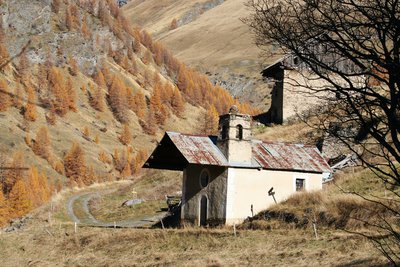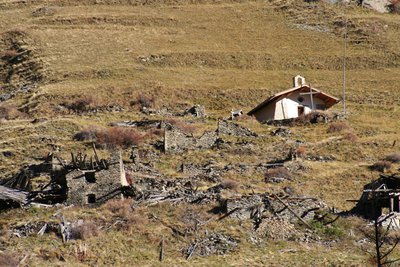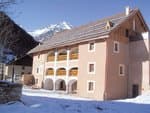
The Montette chapel
In the past, le Roux was surrounded by many hamlets. They were inhabited and the local population used the seasons to rhythm crops, livestock and relations with both sides of the border followed a long way on these alpine lands. Abandoned, the hamlets fell into ruin. Today, under the initiative of an association and of individuals, some buildings tend to reappear. The Montette chapel has thus been rebuilt and the hamlet of Pra Roubaud has had its bread oven as well as other buildings restored. Human life has been resumed here and the testimony of the life of yesteryear are restored. They help us imagine the lives of these men and women who settled here, braved the harsh winters and lived off the riches of the earth.
5 points of interest

Chapelle Saint Antoine de Padou - Benjamin Musella - PNR Queyras  Patrimony and history
Patrimony and historySaint Antoine de Padou Chapel
Little information is available on the chapel. The earliest date is marked on the stoup (1781). Does it correspond to the year the church was built or the year the stoup was made? The building was restored in 1898 by a family from Roux. As for the saint it houses, Saint Antoine de Padou, he was a Franciscan monk of the early 13th century. He was famous for his knowledge of theology and his oratory skills. Nowadays, he is prayed to in order to find lost objects.
Point de vue depuis les ruines de la Montette - Benjamin Musella - PNR Queyras  Panorama
PanoramaView from the Montette
From the ruins of the Montette, we can see the Pic de la Lauze to the right and the Pic du Fond de Peynin far back, to the left. In the foreground, the Montette valley comes out on the Bouchet valley which reaches Abriès
Les ruines de la Montette et sa chapelle restaurée - Benjamin Musella - PNR Queyras  Patrimony and history
Patrimony and historyThe Montette
For 3 centuries, families had lived here. They cultivated the land, producing bread and cheese. They traded with the Italian valleys through the Col Saint Martin. Like many hamlets of the Queyras, the Montette was abandoned little by little in the late 19th century. The Sainte Marie Madeleine Chapel renovated in 2003, is the only building still as is in the old hamlet of Montette. There is a trunk standing in front of the chapel. It is the tree of liberty dating from the revolution. Since then, it has been lifted after each fall.
Fours communautaires de Pra Roubaud - Benjamin Musella - PNR Queyras  Patrimony and history
Patrimony and historyCommunity ovens
For a long time, bread remained the staple food of the inhabitants of Queyras. Every village in the Republic of Escartons had one or more community ovens. Unlike the community ovens in the kingdom of France, no tax was paid by the users, but the rules on sharing were strict. Each family prepared their dough and used the oven in turns. The first family was in charge of lighting the oven. Once finished cooking, the oven was kept warm for the following ones. The following family cooked and kept the oven warm. This system could take several days and the last family was in charge of cleaning the oven. After each cooking, the order of use changed. Thus the lighting and cleaning were done in turns.
Oratoire Saint Joseph - Benjamin Musella - PNR Queyras  Patrimony and history
Patrimony and historySaint Joseph Oratory
Small religious buildings, oratories can be made of different materials and have various shapes. But they usually have a lot in common: a basement, a fluted column (pillar or column which can include the name of the saint and the donor, the date of construction and various information), the niche containing the saint, and the grid protecting the statue. It is topped with a roof and a cross. Here the Saint Joseph Oratory was erected in honour of the foster father of Jesus, patron saint of families, craftsmen, workers, travellers and exiles, gravediggers and the dying.
Description
From the parking lot at the entrance of the village, reach the church on top of the hamlet, continue along the main road until you pass a gate at the exit of the village and continue on the track (GR). Pass the Saint-Antoine de Padou chapel, leave a path on the right and reach the end of the track.
1 - Cross the stream, get on a path towards the ruins of the Montette, cross them and reach the Sainte Marie Madeleine chapel at the top of the hamlet. Turn right (PR) and continue on the rising false flat in the valley of the Col de Saint Martin. Please note the trail is not marked, follow the cairns and the yellow tags.
2 - After1km, take the path on the right, cross the stream again and reach the track 50meters above. Follow the slightly descending track and quickly take a path on the left. After 200m on this path, reach the point"Ancien canal" and continue on a wide path rising slightly.
3 - At Pra Roubaud, go through the hamlet downhill, cross a stream and reach the Saint Joseph's Oratory overlooking Le Roux. Go down a good path to reach Le Roux and the main road (GR). Turn left to reach the church, go down to the village to reach the parking lot.
- Departure : Le Roux
- Arrival : Le Roux
- Towns crossed : Abriès-Ristolas
Forecast
Altimetric profile
Information desks
House of the Queyras Regional Nature Park
3580 Route de l’Izoard, 05350 Arvieux
The House of the Queyras Regional Nature Park is closed to the public.
OTI du Guillestrois et du Queyras
Maison du Tourisme du Queyras, 05350 Château-Ville-Vieille
Transport
05 Voyageur: 04 92 502 505 Tourist Office of Queyras: 04 92 46 76 18
Access and parking
From Abriès take the D441 until Le Roux. Park in the parking area at the entrance of the hamlet or go through the hamlet and park in the church parking lot.
Parking :
Report a problem or an error
If you have found an error on this page or if you have noticed any problems during your hike, please report them to us here:


